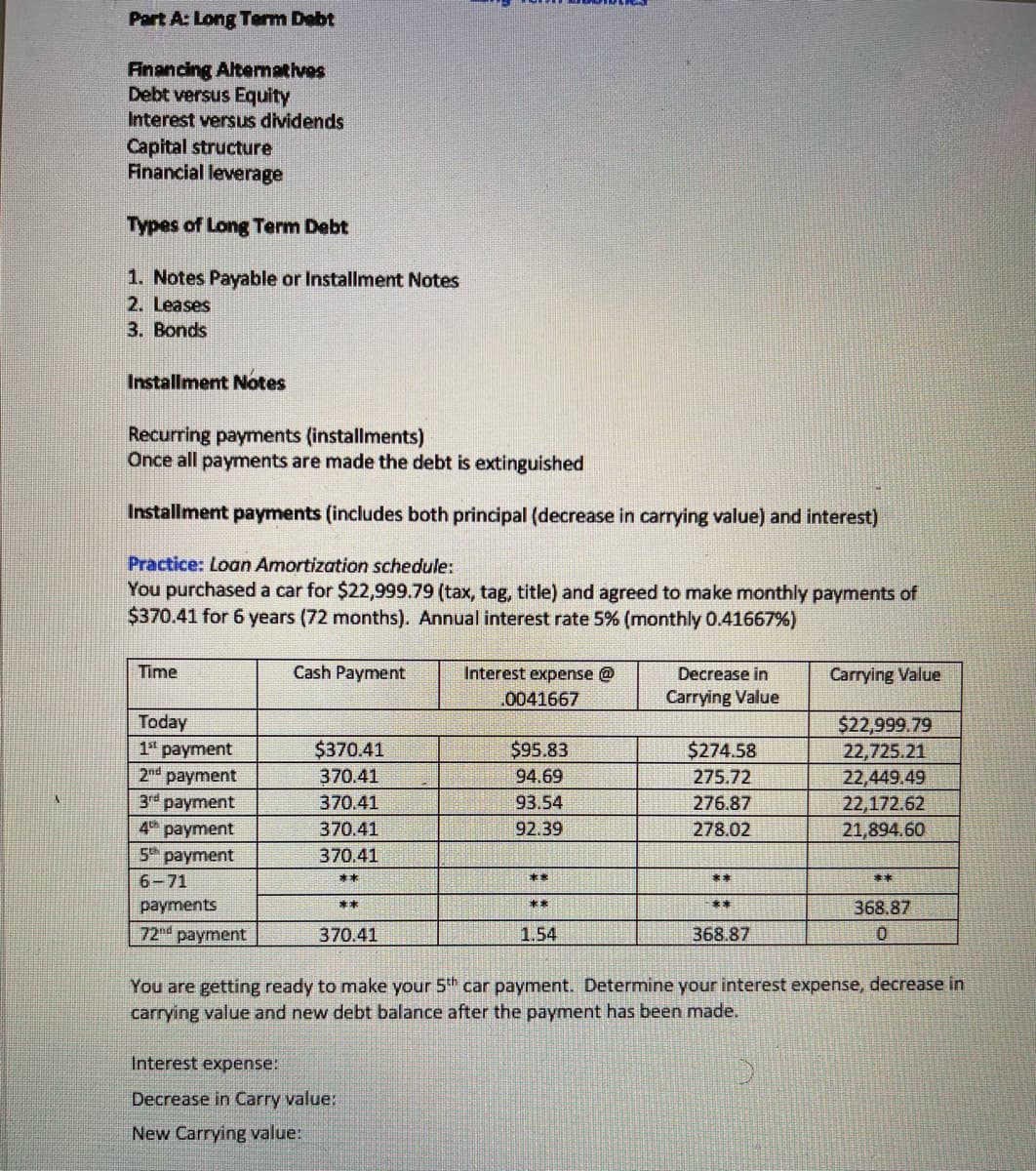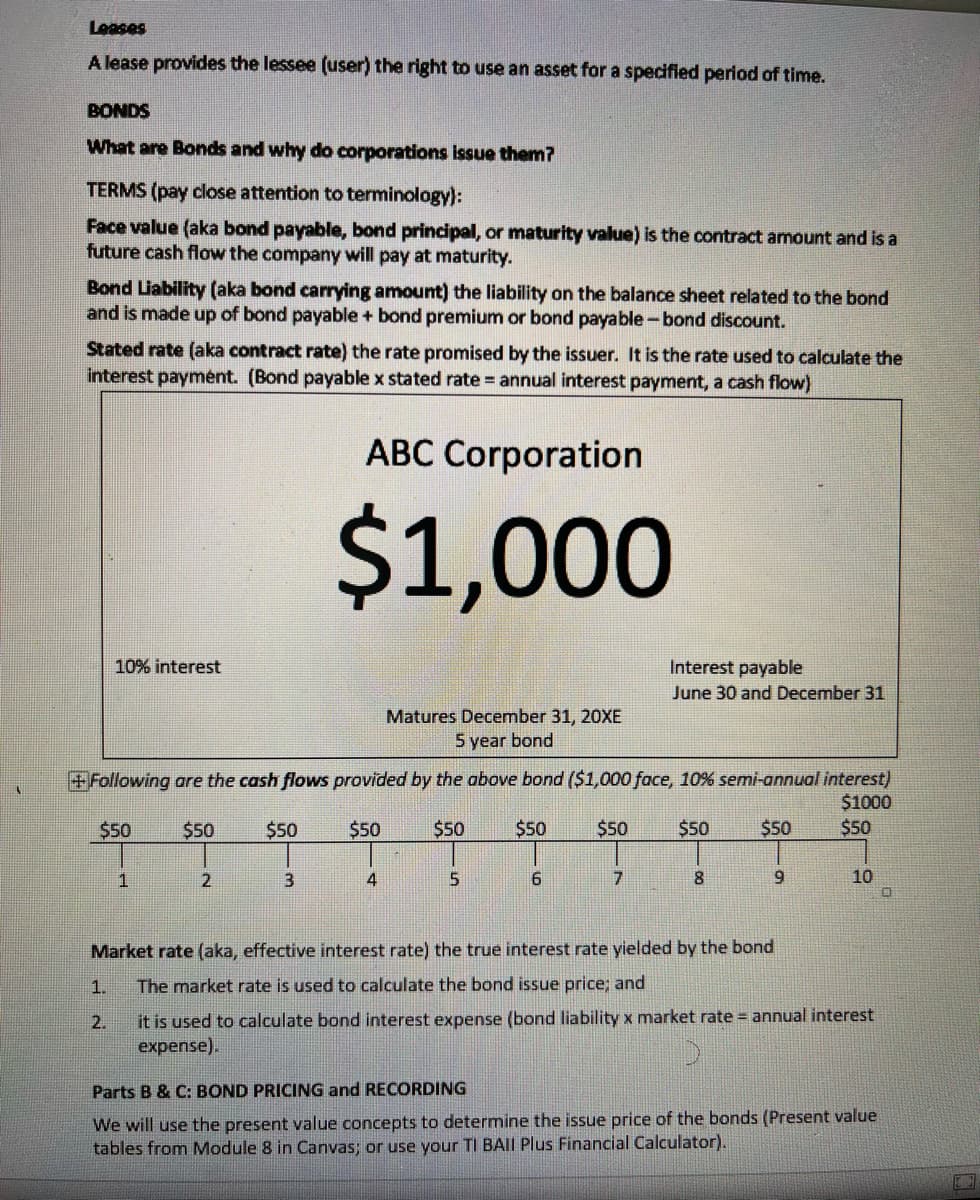2 of the VLN, how do you determine the annuity cash flow (the bond interest payment) from an annual bond? Group of answer choices A. Bond payable x stated rate B. Bond liability x stated rate C. Bond payable x market rate D. Bond liability x market rate
2 of the VLN, how do you determine the annuity cash flow (the bond interest payment) from an annual bond? Group of answer choices A. Bond payable x stated rate B. Bond liability x stated rate C. Bond payable x market rate D. Bond liability x market rate
Cornerstones of Financial Accounting
4th Edition
ISBN:9781337690881
Author:Jay Rich, Jeff Jones
Publisher:Jay Rich, Jeff Jones
Chapter9: Long-term Liabilities
Section: Chapter Questions
Problem 52BE
Related questions
Question
From page 9-2 of the VLN, how do you determine the annuity cash flow (the bond interest payment) from an annual bond?
Group of answer choices
A. Bond payable x stated rate
B. Bond liability x stated rate
C. Bond payable x market rate
D. Bond liability x market rate

Transcribed Image Text:Part A: Long Term Debt
Anancing Altematives
Debt versus Equity
Interest versus dividends
Capital structure
Financial leverage
Types of Long Term Debt
1. Notes Payable or Installment Notes
2. Leases
3. Bonds
Installment Notes
Recurring payments (installments)
Once all payments are made the debt is extinguished
Installment payments (includes both principal (decrease in carrying value) and interest)
Practice: Loan Amortization schedule:
You purchased a car for $22,999.79 (tax, tag, title) and agreed to make monthly payments of
$370.41 for 6 years (72 months). Annual interest rate 5% (monthly 0.41667%)
Time
Cash Payment
Interest expense @
Decrease in
Carrying Value
.0041667
Carrying Value
Today
1" payment
2nd payment
3rd payment
4th payment
5th payment
$22,999.79
22,725.21
22,449.49
22,172.62
21,894.60
$274.58
$370.41
370.41
370.41
$95.83
94.69
275.72
93.54
276.87
370.41
92.39
278.02
370.41
6-71
本本
**
**
**
payments
368.87
**
**
**
72nd payment
370.41
1.54
368.87
You are getting ready to make your 5th car payment. Determine your interest expense, decrease in
carrying value and new debt balance after the payment has been made.
Interest expense:
Decrease in Carry value:
New Carrying value:

Transcribed Image Text:Leases
A lease provides the lessee (user) the right to use an asset for a specified period of time.
BONDS
What are Bonds and why do corporations issue them?
TERMS (pay close attention to terminology):
Face value (aka bond payable, bond principal, or maturity value) is the contract amount and is a
future cash flow the company will pay at maturity.
Bond Liability (aka bond carrying amount) the liability on the balance sheet related to the bond
and is made up of bond payable + bond premium or bond payable-bond discount.
Stated rate (aka contract rate) the rate promised by the issuer. It is the rate used to calculate the
interest paymént. (Bond payable x stated rate = annual interest payment, a cash flow)
ABC Corporation
$1,000
10% interest
Interest payable
June 30 and December 31
Matures December 31, 20XE
5 year bond
+Following are the cash flows provided by the above bond ($1,000 face, 10% semi-annual interest)
$1000
$50
$50
$50
$50
$50
$50
$50
$50
$50
$50
1
4
8.
9.
10
Market rate (aka, effective interest rate) the true interest rate yielded by the bond
1.
The market rate is used to calculate the bond issue price; and
it is used to calculate bond interest expense (bond liability x market rate annual interest
expense).
2.
Parts B & C: BOND PRICING and RECORDING
We will use the present value concepts to determine the issue price of the bonds (Present value
tables from Module 8 in Canvas; or use your TI BAII Plus Financial Calculator).
Expert Solution
This question has been solved!
Explore an expertly crafted, step-by-step solution for a thorough understanding of key concepts.
This is a popular solution!
Trending now
This is a popular solution!
Step by step
Solved in 2 steps

Knowledge Booster
Learn more about
Need a deep-dive on the concept behind this application? Look no further. Learn more about this topic, finance and related others by exploring similar questions and additional content below.Recommended textbooks for you

Cornerstones of Financial Accounting
Accounting
ISBN:
9781337690881
Author:
Jay Rich, Jeff Jones
Publisher:
Cengage Learning

Financial Accounting: The Impact on Decision Make…
Accounting
ISBN:
9781305654174
Author:
Gary A. Porter, Curtis L. Norton
Publisher:
Cengage Learning

Intermediate Accounting: Reporting And Analysis
Accounting
ISBN:
9781337788281
Author:
James M. Wahlen, Jefferson P. Jones, Donald Pagach
Publisher:
Cengage Learning

Cornerstones of Financial Accounting
Accounting
ISBN:
9781337690881
Author:
Jay Rich, Jeff Jones
Publisher:
Cengage Learning

Financial Accounting: The Impact on Decision Make…
Accounting
ISBN:
9781305654174
Author:
Gary A. Porter, Curtis L. Norton
Publisher:
Cengage Learning

Intermediate Accounting: Reporting And Analysis
Accounting
ISBN:
9781337788281
Author:
James M. Wahlen, Jefferson P. Jones, Donald Pagach
Publisher:
Cengage Learning

Financial Reporting, Financial Statement Analysis…
Finance
ISBN:
9781285190907
Author:
James M. Wahlen, Stephen P. Baginski, Mark Bradshaw
Publisher:
Cengage Learning